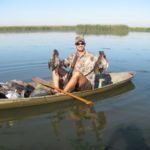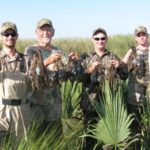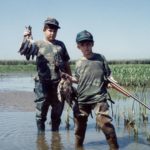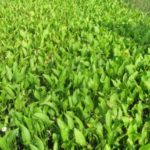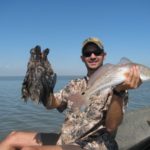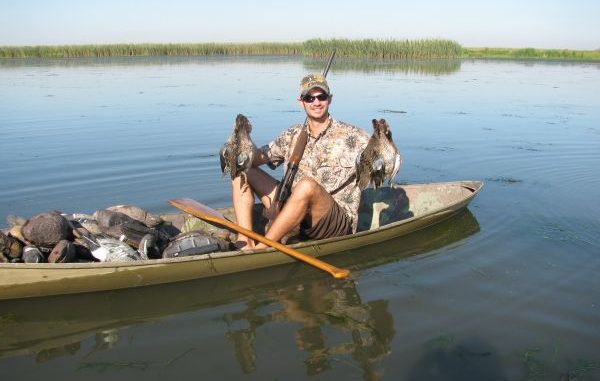
A lot has changed for duck hunters over the past few years, as hurricanes have buffeted the coast. But one thing remains constant — teal flock to the mouth of the Mississippi River. Here’s how to score quick limits.
The whooping! The high-fiving! Those glowing FACES!
Everyone at Tad Gormley Stadium on Sept. 16, 1964, for the Beatles knows the faces. All Louisianans watching the Alabama-LSU match-up (also known as “da Game of da century”) on Nov. 5, 2011, when overtime ended also know it.
Anyone at the Superdome at about 10 p.m. on Feb. 7, 2010, would also instantly recognize the looks on these faces.
The teal season, you see, had just been officially announced on Doc’s backyard gazebo, which was still redolent of the crab and crawfish-boiling water that somebody had forgotten to empty from the pot atop the burner the very festive evening before.
Pelayo made the teal announcement. He opened the sports section of the paper first, as Priscilla handed him a Bloody Mary ( heavy on the celery, pickled okra and string beans — a “Bloody Mary Salad” we’ve come to call them) and bellowed the news.
All the males erupted, as the gals shrugged, and then tried calming the racket. “Shuuuuuush!” said Trisha with a manicured finger pressed to her glossy lips. “Neighbors are still sleeping!”
“OK, OK!” counseled Priscilla, while frowning and putting down her Mimosa and flapping her perfectly-toned arms downward — actually looking like a decoying teal in the process.
But the above scene was in July 1992. Teal season had been closed for four years. And the hair color and girth of the crowd on Doc’s gazebo that day more resembled the cast of “Friends” than the cast of Duck Dynasty.
Fast forward 22 years to the same setting, same crowd, same victuals and drinks, same official and loud teal season announcement.
But whoops!
Remember Bluto in Animal House? Remember his famous: “Was it over when the Germans bombed Pearl Harbor! Let’s GOOOOOOO!” Remember how many people followed him as he ran out the room? Remember the looks on their faces — and on Bluto’s himself — when he sheepishly walked back into the room?
And remember when Otter blurted his famous, “OTIS MY MAN!” at the nightclub? Remember Otis Day’s face in response?
OK, you get the picture. Those were the reactions and faces to Pelayo’s teal season announcement two months ago. Things have changed.
“Man, I ain’t up to fighting all that heat and mud,” wailed Artie.
“And fighting all the mosquitoes!” Eddie added.
“I’ll be down there at da houseboat,” snapped Master of Ceremonies Doc Fontaine himself. “But for the dy-no-mite September fishing! No way I’m getting up at 4 a.m. to be ready for prime teal shooting time. ’Cause everybody knows teal are notorious crack-a-dawn flyers! Man I ain’t ready for all dat fuss!”
“And PLEASE don’t tell me we’re hunting public land!” sighed Spencer with an eye roll. “Man, I remember fighting all those crazy crowds at Manchac, Pearl River, Pointe-au-Chenes and Wax Lake years ago! Maniacs motoring right through your decoys! Then settin’ up 60 yards away! — UNH-UNH! No way! Count me out! You gotta be outcha mind. I’m too old for fighting wit all dat stuff nowadays!”
Pelayo took the rebuttals serenely, nodding amiably at the angry and disgusted faces around him while calmly crunching through his Bloody Mary Salad.
“Are y’all finished?” he finally smiled, while savoring a final okra bite. “Fine. OK, now listen up.”
One by one, Pelayo addressed every one of the teal-hunting complaints — and methodically demolished them.
Our teal hunting, you see, takes place in the Mississippi River Delta, where crack-of-dawn hunting (while certainly fruitful) is not mandatory, where almost 160,000 acres (about a third of which prohibit surface drives) means the hunters are well spread out and where absence of completely stagnant waters (river currents and tides are always zipping in and out) means very few mosquitoes even at dawn and even in the heat of September.
And get this: Dekes can often be set out and ducks retrieved by walking! A high river, you see, often builds firm sandbars in choice hunting areas.
And, oh, another significant detail: Since the “special teal season,” (as it was first called) started running back in 1968, the aerial duck counts for Louisiana have shown one thing consistently — the greatest concentrations of teal, by far, in Southeast Louisiana cram into the Mississippi Delta.
The reasons are not hard to understand.
Here’s the very tip of the Mississippi Flyway funnel, the continent’s main thoroughfare for migrating waterfowl. For millennia, the Mississippi and its tributaries have served as a network of highways for migrating ducks. Traditionally almost a third of North America’s wildfowl wintered in these marshes every year.
Now, since Katrina — as all us fanatical Southeast Louisiana duck hunters well know — the pattern has changed. Whether consistent flooding of Midwest crop fields or something else caused the change in migration patterns, it’s hard to say.
But it’s evident to all who duck hunt in Southeast Louisiana consistently.
Fortunately, teal migrate well before the freezes, so — for whatever reason — their traditional migratory pattern still holds. They still flock into the lush Mississippi Delta marshes whenever hurricanes and tropical storms give them the chance. They find the place — to quote Robert Palmer — “simply irresistible.”
And with good reason. Maps show how Louisiana juts out into the Gulf below the coasts of Texas and Mississippi. A little sliver of a peninsula bordering the river below New Orleans juts out even farther.
That was the river’s doing — at least until the levees shackled it. For 10,000 years, this “father of all waters,” as the Indians called it, whipped back and forth across the landscape like a huge (but somewhat lethargic) Water Wiggle, depositing its fertile cargo of sediment.
The river robs Peter to pay Paul, in a sense. Iowa’s loss is our gain — until the levees went up, that is. Most of Louisiana below Interstate 12 thus sprouted. In geological terms, something “sprouts” in 10,000 years.
These fertile mud flats sprout thick orchards of prime waterfowl fodder every spring, and certain areas remain thick and green practically year round (barring hurricanes).
And, according to recent figures from Ducks Unlimited, Louisiana hunters still kill more ducks than those of the next three states in the rankings combined.
The “bird-foot Delta” is what they call this area where the levees that straightjacket the Mississippi finally stop and the main river splits into channels like the toes of a chicken. That fertile cargo of sediment spreads out here to build marsh — or “wetlands” in fashionable lingo.
Alas, this marsh-building process got a serious whammy again last September with Hurricane Isaac. But that same super-high river (that played havoc with our Delta fishing this year) nursed the Delta marshes back to robust health in no time.
The marshes are chock-full of lush seeds and grasses for teal.
“When life hands you a high river,” we long ago resolved, “make teal gumbo and jambalaya.”
The spoil banks and ridges are lush and green with peavine and bachiris. The roseau stands are already sprouting anew. The shallow deltas (rebuilt and lovingly nourished by the high river this spring and summer) off Romere and South passes are sprouting in fresh growths of delta duck potato, and the nearby ridges are thick with wild millet. Both of these are prime teal fodder — the equivalent of white oak and honeysuckle for deer.
Teal prefer shallow fresh marsh, and like most puddle ducks (except gadwall), they prefer feeding on seeds rather than underwater vegetation. In September in the Delta, teal find the best of both.
Vast orchards of duck potato and three square sprout from the new sandbars. The older and taller duck potato provides little bouquets of seeds with the flowers.
By Thanksgiving, the duck potato plants have mostly wilted, and the pintail and geese flock to the sites to root for the tubers in the mud. But in September, they’re providing seeds for the teal, mottled ducks and impatient pintail.
And even better, thick stands of wild millet still stand in September. This stuff is like corn, wheat or rice for wild ducks. When that tide comes up, all those little seeds float to the surface, and the teal pour in to feast. You want to be near one of these spots when it happens, believe me. It’s very similar to rice-field teal hunting at the crack of dawn.
Alas, the entire Delta is not uniformly blanketed with teal. For whatever reason (my guess is the prevalence of new, shallow mini-deltas that sprout in their favorite fodder), the legally huntable areas in the Delta National Wildlife Refuge and the new sandbars off South pass at Pass A Loutre WMA usually hold the most teal.
As usual in September, Doc’s houseboat was at full capacity. But only Pelayo, Chris, “On-the-Ball” Paul and I opted to hunt.
Now here’s the funny part: we slept in later than the fishermen — and fishergals!
As mentioned, dawn setups aren’t mandatory down here. The high tide was at 8 a.m., and the winds were light. Which meant they’d probably kick up a bit around 9 and get the teal moving again.
So, as usual, we opted for “the second shift” of teal hunting, as we call it.
At 7:30 a.m., we were just turning into Main Pass from the river. A glorious sight greeted us: The morning sun rimmed the clouds to the east with a red glow, the duck potato and three square sprouted in vivid green from the fresh sandbars near the bank, the darker elephant ears on the older, higher bars were behind. The leafy roseau and willows swayed in the light breeze. Mullet, reds and gar pushing their distinctive wakes through the weedy shallows.
A vibrant marsh. A living marsh. A marsh rejuvenated every spring by the sediments gleaned from the fertile heartland of our continent by the father of all waters.
The air was fragrant with peavine and elephant ears, a smell that says “teal limits followed by reds and flounder!” to those of us who come down in September — the peak season for both.
And YES! Flocks of teal were fluttering through the skies above the marsh — dipping, rising swerving, now shooting skyward — blam! blam! — as the distant shots echoed across the marsh.
The bigger mottled ducks, mostly in pairs, were almost as numerous. And way up there — looked like, yep — pintail, in a ragged V formation.
A glorious ambiance, my friends. We were enraptured as we turned into the pass. Teal were everywhere.
Pelayo was at the helm pointing toward the marsh with a smile a mile wide. And, yes, several boats were already passing us on the way back. Apparently they’d already limited out.
As mentioned, we prefer this “second shift.”
Without one of those freak September fronts or a low-pressure system in the Gulf to create wind, the best shooting for teal generally occurs after 9 a.m., in our experience. That’s when the wind starts.
We’ve seen it time and again. At dawn, it’s still and sweltering. Sure, some teal are flying around. And sure, you’ll get some shots — probably a two-man limit in no time. But we need a four-man limit from one place.
And we have never failed to get it from 9 a.m. to 11 a.m.
We turned left off Main Pass, and set up no more than a quarter of a mile down a skinny pass. For teal there’s no need to hunt the big expanses of water with the roseau islands. We hunt these on low-tide situations for pintail and greys during the big season. No reason for that now.
As mentioned, teal like the shallow, weedy, seedy ponds surrounded by wild millet, three-square and duck potato. These are created by the new mini-deltas just off the main passes.
Chris and I set out the 20 decoys from the ’rouge in just such a place, as Pelayo and On-The-Ball Paul jammed the second “shooting ’rogue” into some bulrushes and stuck a few palmettos around it.
“Nice shot!” I howled as Paul folded a single flying directly overhead. He almost landed in our ’rogue. Pelayo and Paul had downed three by the time Chris and I finally joined them. “Mind if we take a turn?!” Chris snarled.
“DOWN!” Pelayo answered, as we nestled onto the “shooting bench” that fits lengthwise in the shooting ’rogue.
Yep. A huge flock, maybe 30, had seen the dekes and were making a wide circle.
Geezum, what a sight. Eight months of anticipation glowed from every face. Trigger fingers tapped safeties. Anxious eyes followed the flock as it neared.
As it swerved. Back. Forth. It was too much for the nervous system. I had to stifle a guffaw.
Not yet — not yet — OK — NOW!
Blam-blam-blam! Blam-blaam!
They rocketed skyward above us, and we wrenched our necks trying to follow them.
Blam! Blam!
TEN shots and TWO fell from the fusillade into the perimeter of the dekes. We were in hysterics.
“We waited too long!” I howled. “Geezum! Will we never LEARN!”
Moral of the story: Let big ducks get as close as possible before rising. They back peddle with the wind and are out of range in seconds. Teal, on the other hand, rocket skyward right over you. It’s best to get up before they hit the edge of the dekes.
But no time for recriminations.
“On the left!” Chris pointed.
Ah, yes, five winging in low — gliding — wings just cupping.
“NOW!” I hissed.
We got up, and they shot skyward. But at 25 yards, they presented perfect targets — like a shooting gallery.
Blam-blam! BLAAM!
Four fell.
“Now we’re getting somewhere!” Pelayo howled.
The whoops and high fives lasted another two minutes. Then more shooting. More flocks. A single now. A double.
Sure enough — those roseaus were swaying. That late-morning wind had them stirred up.
By 10:37 a.m,, we’d limited out — 16 teal. (That was in 2011; this year the limit is 6 per person.)
“OK, gang,” On-The-Ball announced. “Time for the reds and flounder along the river riprap near the mouth of Baptiste Collette.”
And off we went, a glow on our faces and a song in our hearts.
